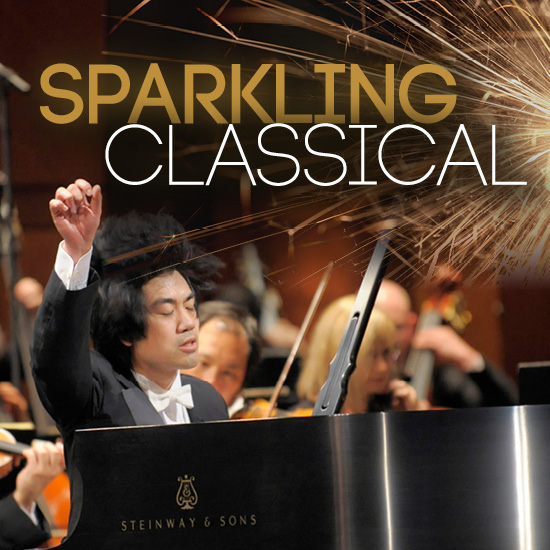September 9-10, 2023
PROGRAM NOTES: Sparkling Classical
Dance Card
Jennifer Higdon (b. 1962, Brooklyn, NY)
Composed in 2015.
Premiered on May 4, 2016 in Berkeley, CA.
Instrumentation: Strings
Duration: Raucous Rumpus (2 min.), Celestial Blue (6 min.), Machina Rockus (3 min.)
Composed for Nadja Salerno-Sonnenberg and the New Century Chamber Orchestra in the Bay Area, California, Dance Card is a multi-movement work for strings about which the composer jokes, “reflects the way she dances – all over the place.” Jennifer Higdon’s characteristic energetic rhythmical play may be jaunty, but its sophisticated structure and drive can hardly be described as “all over the place.”
Raucous Rumpus relies on rapid-fire call and response rhythmic elements with sinuous scales concurrently passed between the various string groups. Celestial Blue’s slower pulse is nevertheless infused with energy from surging solos among the principal players joined in dramatic climaxes by the full complement. Machina Rockus’ impulse comes from a sense of layering rhythmical figures amplified by intensifying harmonic “switchbacks.”
Jennifer Higdon is one of America’s most acclaimed figures in contemporary classical music, receiving the 2010 Pulitzer Prize in Music for her Violin Concerto, a 2010 Grammy for her Percussion Concerto, a 2018 Grammy for her Viola Concerto and, most recently, a 2020 Grammy for her Harp Concerto.
Higdon’s first opera, Cold Mountain, won the International Opera Award for Best World Premiere and the opera recording was nominated for 2 Grammy awards. In 2018, Higdon received the prestigious Nemmers Prize from Northwestern University which is awarded to contemporary classical composers of exceptional achievement who have significantly influenced the field of composition. Higdon enjoys several hundred performances a year of her works and her works have been recorded on more than seventy CDs.
©2023 Michael Christie
Burleske in d minor for piano and orchestra
Richard Strauss
(b. Munich 1864; d. Garmsich-Partenkirchen, 1949)
Composed in 1885-1886.
Premiered on June 21, 1890 in Eisenach, Germany.
Instrumentation: piccolo, two flutes, two oboes, two clarinets, two bassoons, four horns, two trumpets, timpani, strings.
Duration: approximately 20 minutes.
Richard Strauss was acknowledged as an unusual talent in his late teens; premieres of early works drew the attention of Germany’s lauded musicians and critics. Early in 1885, he assumed the post of assistant conductor in Meiningen, where he also appeared as piano soloist with the orchestra.
in addition to his responsibilities for an occasional solo appearance and conducting the daily morning rehearsals of the Meiningen Orchestra, Strauss in the autumn of 1885 “started to compose a scherzo for piano and orchestra (Burleske). It is the earliest of Strauss’ works to hint at the masterpieces to come. Strauss never explained the title. He first called the piece a “scherzo,” which literally means “joke,” and he may have intended some humorous allusion for the music. The Burleske is a work of high spirits with no trace of profundity — a dazzling showpiece for the virtuoso pianist. In it are clearly heard Strauss’ awesome gifts for melody, orchestration, musical characterization and thematic development that were to blossom just two years later in his first undisputed masterpiece, Don Juan.
©2013 Dr. Richard E. Rodda
Danses Exotique (version for 11 wind instruments and percussion, 1981)
Jean Francaix
(b. Le Mans, France, 1912; d. Paris, 1997)
Composed for two pianos in 1957.
Premiered on December 5, 1830 in Paris, conducted by François Habeneck.
Instrumentation: piccolo, flutes, two oboes, two clarinets, bassoon, contrabassoon, saxophone, two horns, percussion.
Duration: approximately 11 minutes.
Jean Francaix came from a family of musicians, his father, a musicologist, composer and pianist, and his mother, a singer. He began composing at age six and was recognized for his talents by leading composers of the time, including Nadia Boulanger, teacher of the twentieth century’s greatest composers. Boulanger considered him to be one of the very best of her students.
Francaix composed over 200 works in a staggering variety of styles; his skills both as a composer and pianist were so developed that he frequently gave the world premieres and subsequent performances of his own works. Of particular note was Francaix’s embrace of “non-classical” musical styles and “non-orchestral” instruments. His style is marked by a conversational interplay among musical lines and a light, cheerful disposition generally.
His Exotic Dances for two pianos was composed in 1957 and have been rearranged for numerous combinations, including this version for wind ensemble and percussion. His musical vocabulary focuses on transparency even though many voices are often performing at the same time. One can sense when the texture is about to become too dense and hear Francaix thin out the instrumentation so that every voice can be heard.
He was keenly aware of the influence of North and South American musical entertainment in France during World War Two and his Exotic Dances meld traits of each home country’s dance, with a French musical undertone.
1. Pambiche is a dance of the Dominican Republic. It is a slower version of the “Merengue,” and is often called the “yankee-style merengue” as a nod to the presence of US military personnel during the occupation of the DR.
2. Baiao is a popular, sultry dance of Northeastern Brazil. Its syncopated duple meter brings together indigenous, African and European influences.
3. Nube gris is essentially a waltz in duple meter! It originates from the Quechua people of the Peruvian Andes.
4. The Merengue is the national dance of the Dominican Republic, recognized by UNESCO on its list of the Intangible Culture Heritage of Humanity. Francaix creatively incorporates a traditional five beat rhythmic pattern within the dance’s characteristic vigorous duple meter pulse. This dance-form has evolved greatly over decades and influenced the musical styles of other Caribbean regional dances.
5. The Mambo was pioneered in Cuba during the late 1930s. The final beat of each bar of four pulses is accentuated as here by Francaix. Although the mambo is generally brisk, there is still an elegant characteristic which has encouraged many performers to play subsequent versions in a more sultry tempo, furthering its popularity as it came to dominate Mexican and American musical dance halls in the 1940s and 1950s.
6. The origin of Samba is attributed to Afro-Brazilian communities of the late 19th century in the Rio de Janiero region. The evolution of samba from its origins among the black slaves who made up more than half of the population of Rio saw its popularity grow throughout the country via radio broadcasts, its settings in popular gatherings such as parades, and then codified in various forms as a professional dance endeavor. In this version, Francaix imposes syncopation by writing in an irregular 5/8 (five swift pulses per bar) pattern.
7. Malambeando, another name for the folk dance of Argentina, the Malambo. Traditionally, men dance with elaborate leg movements and artistically planned stomping. In this version, the stomping can be heard from the tambourine.
8. It’s fun hearing what a composer writing in the 1950s considered Rock ‘n’ Roll! A brief solo saxophone figure sweeps us into a jazz-laden version of 50’s rock. Francaix famously wrote, “my music is jolly most of the time, and occasionally comical. But it always aims to give pleasure.”
©2023 Michael Christie
Concertino for Piano and Orchestra
Jean Francaix
(b. Le Mans, France, 1912; d. Paris, 1997)
Premiered on December 15, 1934
Instrumentation: two flutes, two oboes, two clarinets, two bassoons, two horns, two trumpets, two trombones.
Duration: approximately 12 minutes.
Françaix was the soloist in the premiere of his Concertino for piano and orchestra in 1934, just a few years after winning the first prize for piano at the Paris Conservatoire in 1930. This Concertino was one of his earliest successes and still one of his best-known compositions. The first movement’s busy perpetual motion exudes a witty, colorfully orchestrated style that was to serve him well throughout a long composing career. The banter between soloist and orchestra is mostly of miniaturized figures allowing for a maximum number of exchanges in a compact form.
The slow movement’s serenely curving melody and virtually static harmonic progression could not be a greater contrast to the frolicking surrounding movements.
The Allegretto/Trio is a simple three part “ABA” vignette with playful woodwind and brass figures offering material for the pianist to expound upon. A miniature trio section can be identified by the pastorale repeated figures in the left hand.
A breezy, syncopated Rondeau in 5/8 time follows, bustling with brilliant virtuosic figures in the piano with jazzy figures from the trumpet and fellow wind players. Note how the color of the trumpet figure changes when the player inserts a mute into the bell. The movement ends with a gentle keyboard flourish, dissolving into the air.
©2023 Michael Christie
Symphony No. 1 in D major, Op. 25, Classical
Sergei Prokofiev
(b. Sontsovka, Russian Empire 1891; d. Moscow, 1869)
Composed in 1917.
Premiered on April 18, 1918 in Saint Petersburg, Russia.
Instrumentation: two flutes, two oboes, two clarinets, two bassoons, two horns, two trumpets, timpani, strings.
Duration: approximately 16 minutes.
Prokofiev’s penchant for using Classical musical idioms was instilled in him during the course of his thorough, excellent training: when he was a little tot, his mother played Beethoven sonatas to him while he sat under the piano; he studied with the greatest Russian musicians of the time — Glière, Rimsky-Korsakov, Liadov, Glazunov; he began composing at the Mozartian age of six. By the time he was 25, Prokofiev was composing prolifically, always brewing a variety of compositions simultaneously. The works of 1917, for example, represent widely divergent styles — The Gambler is a satirical opera; They Are Seven, a nearly atonal cantata; the Classical Symphony, a charming miniature. It was in 1916 that Prokofiev first had the idea for a symphony based on Viennese models, and at that time he sketched out a few themes for it.
The work is in the four movements customary in Haydn’s symphonies, though at only fifteen minutes it hardly runs to half their typical length. The dapper first movement is a miniature sonata design that follows the traditional form but adds some quirks that would have given old Haydn himself a chuckle — the recapitulation, for example, begins in the “wrong” key (but soon rights itself), and occasionally a beat is left out, as though the music had stubbed its toe. The sleek main theme is followed by the enormous leaps, flashing grace notes and sparse texture of the second subject. A graceful, ethereal melody floating high in the violins is used to open and close the Larghetto, with the pizzicato gentle middle section reaching a brilliant tutti before quickly subsiding. The third movement, a Gavotte, comes not from the Viennese symphony but rather from the tradition of French Baroque ballet. The finale is the most brilliant movement of the Symphony, and calls for remarkable feats of agility and precise ensemble from the performers.
©2013 Dr. Richard E. Rodda

